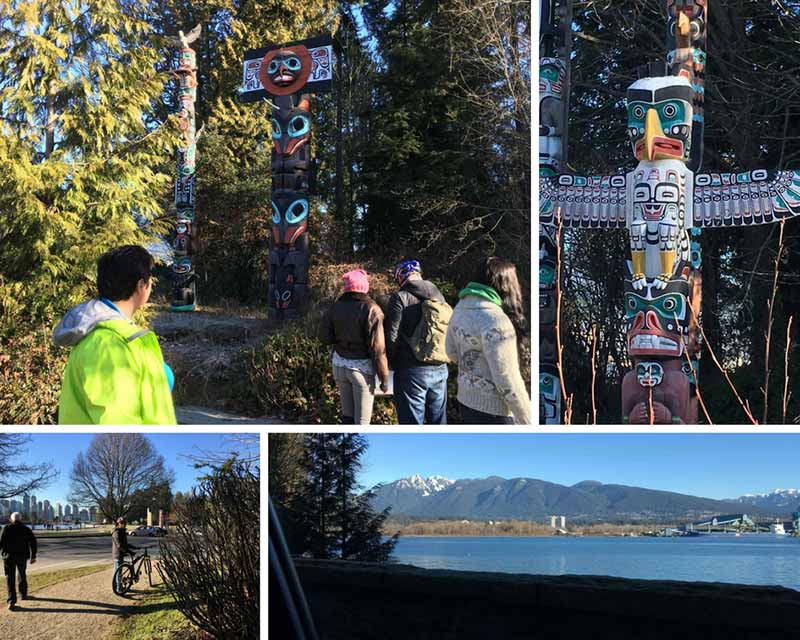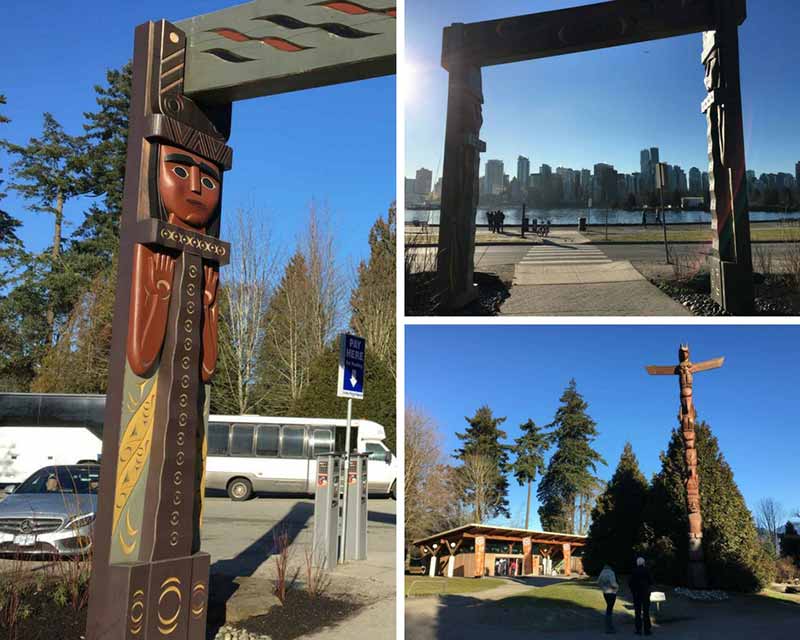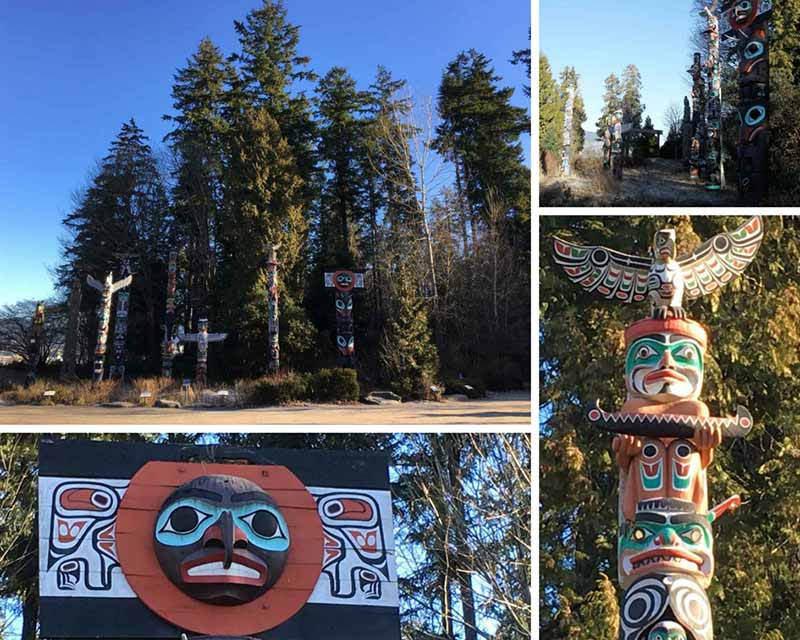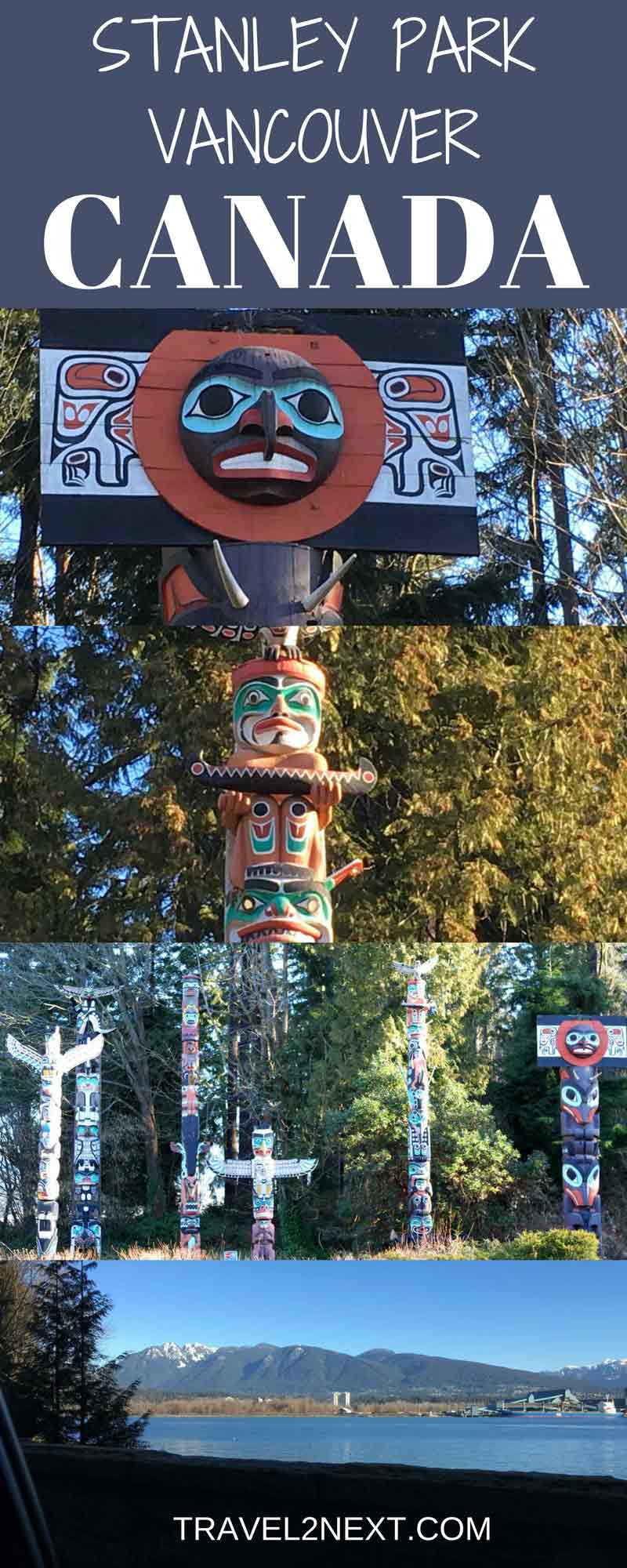Look closely at the totem poles in Vancouver’s Stanley Park and you’ll see animals such as eagles, ravens, bears, orcas, frogs and wolves etched into the poles. The Stanley Park totem poles at Brockton Point represent the stories and legends of several First Nations tribes from British Columbia’s west coast.
Watch this video interview with Candace Campo from Talaysay Tours and learn the secrets of the Coast Salish welcome gates or read a transcript of the interview below. Visiting Stanley Park is one of the top things to do in Vancouver.
What is a totem pole?

To some people, totem poles might look like works of art.
But to the Haida, Nuxalt, Kwakwaka’wakw, Tlingit, Tsimshian and the Coast Salish people, totem poles are a way of storytelling and keeping records that date back thousands of years.
In Stanley Park, totem poles of various First Nation tribes stand on the traditional territory of the Coast Salish people.
There’s one totem pole carved by Robert Yelton of the Squamish Nation, whose traditional territory is Stanley Park.
But aside from totem poles, you might also be interested in the Coast Salish welcome gates.
These gates are sacred pathways with fascinating secret symbols.
Here’s a video transcript:
Coast Salish artwork

Candace Campo: People of this land are Squamish, Tsleil-Watuth and Musqueam.
And now we’re happy to share that we do have representation from the three tribes that have lived in this area for millennia.
These are Coast Salish welcome gates and the carvings are distinctly Coast Salish iconography.
It’s very common that when you go to a village you’ll see a gateway like that because it’s a pathway. And pathways are considered sacred.
So in a positive and negative depiction, this is the eye of the crater, this circle.
When you see this symbol, it is predominantly a Coast Salish symbol. When we travel and we wanted people to know that we were friendly and not foe. The delegation in the canoe would show this symbol of the eye of the crater. And when you saw that eye you knew it was family and friends.
Revitalisation of Coast Salish art
This work is done by the highly respected Susan Point, the foremother of the revitalisation of Coast Salish art.
The reason I refer to this as “revitalisation” is because in the early years of colonisation we were forbidden to do our artwork.
It was considered pagan and it was illegal for us to speak our own language and to do our artwork.
It was even, at one point, illegal for us to congregate as a people.
So, we’re past that now and art is highly respected.
And artists are highly renowned in our community and their works tell of our relationship to each other and, equally important, our relationship to our land and the history of our peoples.
Totem poles in Stanley Park
Coast Salish people typically didn’t have very high erect totem poles.
We usually have welcome figures, such as the gate you see here, which would be one human figure or possibly two figures.
That’s what differentiates southern art from northern art.
As an artist myself, I have the utmost respect for the art for both our south coast and our north coast.
What has changed from 200 years ago is we are very intermarried.
If you are married into a northern tribe or you’re a descendent of a northern person you have the rights to do the artwork.
If you are not of northern descent of that tribe, that is their code and their laws so you’re not able to do the artwork.
We’re seeing a transition of both the south and the north.
There’s a bit of fusion but also strong protocols to follow.
Christina Pfeiffer: So when you say you’re not allowed to do the artwork what stops you from it?
Candace Campo: It’s respect. Yep. To respect that tribe that that’s their language and their way of expressing their worldview, their history and their laws.
Christina Pfeiffer: So art is more of a way of communication?
Candace Campo: It’s very much so. In fact, many First Nations and indigenous people throughout the world do not have a word for art because the production of the work is for us, so much more. Yeah, even our spiritual connections.
Stanley Park totem poles
Candace Campo: The northern poles I was referring to; they were the first poles erected in Stanley Park; some of them in the 1950s. They’re definitely beautiful poles. They have their own stories and legends and history associated with them.

Christina Pfeiffer: So the carvers from these poles would have been from different communities….
Candace Campo: Yes, what has happened is some of the poles have lived their lifespan and have gone back to the earth, so to speak, and there have been a few poles that have been redone.
It’s usually the younger relatives of the first people who carved them that would have been commissioned to redo the pole. But culturally – usually when the pole has had its lifespan and has fallen, in our culture, because we believe a tree has spirit and so does the pole – you leave the pole on the ground.
Christina Pfeiffer: The styles (of these poles) are very different…
Candace Campo: They very much are. Here you have Kwakwaka’wakw, Nuxalt, Tsimshian and the Coast Salish. They’re all different tribes with their own languages, their own art and customs.
Christina Pfeiffer: That one there. The little one at the back is fascinating to me. It looks almost like it’s communicating some kind of language.
Candace Campo: It definitely is and there are definitely a lot of rich stories associated with the poles.
Candace Campo is the owner, head kayak guide and storyteller at Talaysay Tours. Christina Pfeiffer was a guest of Destination Canada, Destination British Columbia and Tourism Vancouver.
Discover Canada
If you’re interested in authentic First Nations tourism experiences in Canada, you might be surprised to discover there are over 200 aboriginal tourism businesses in British Columbia alone. Here are
10 Cool First Nations Hotels in British Columbia
Where are the totem poles in Stanley Park?
The Stanley Park totem poles are at Brockton Point in the eastern part of Stanley Park, north of Coal Harbour. Stanley Park is in Vancouver’s West End. You can drive, take the transit, walk or bike to and around the park.
Talaysay Tours’ Spoken Treasures Tour is an easy walk with an aboriginal guide who will share stories, history and legends. There are plenty of storytelling stops and the tour is a great opportunity to learn more about British Columbia’s First Nations culture and history.
More ideas:

Plan Your Trip

Rent A Car – Find the best car rental rates at Discover Cars. They compare car hire companies to provide you with the best deal right now.

Find A Hotel – If you’re curious about this article and are looking for somewhere to stay, take a look at these amazing hotels.





